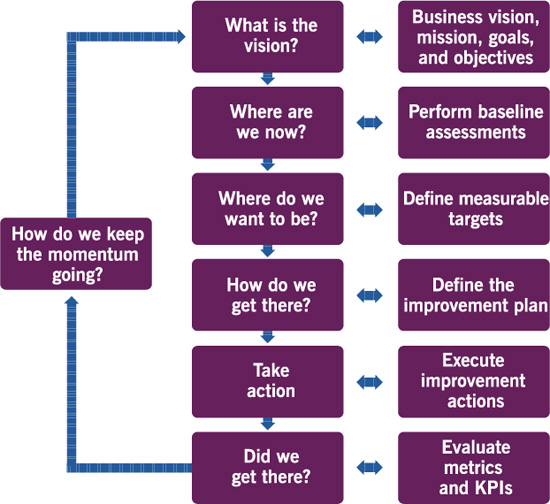ITIL Foundation recap
This section provides a brief recap of the concepts introduced in ITIL® Foundation: ITIL 4 Edition.
The key components of the ITIL 4 framework are the ITIL service value system (SVS) and the four dimensions model.
The ITIL service value system
The ITIL SVS represents how the various components and activities of the organization work together to facilitate value creation through IT-enabled services. The structure of the ITIL SVS is shown in Figure 0.1.
The core components of the ITIL SVS are:
• the ITIL service value chain
• the ITIL practices
• the ITIL guiding principles
• governance
• continual improvement.

Figure 0.1 The ITIL service value system
The ITIL service value chain
The central element of the SVS is the service value chain, an operating model which outlines the key activities required to respond to demand and facilitate value realization through the creation and management of products and services. The service value chain is shown in Figure 0.2.
The ITIL service value chain includes six value chain activities which lead to the creation of products and services and, in turn, value. The activities are:
• plan
• improve
• engage
• design and transition
• obtain/build
• deliver and support.

Figure 0.2 The ITIL service value chain
The ITIL practices
Practices are sets of organizational resources designed for performing work or accomplishing an objective. The ITIL SVS includes 14 general management practices, 17 service management practices, and three technical management practices. These are outlined in Table 0.1.
Table 0.1 The ITIL management practices
General management practices |
Service management practices |
Technical management practices |
Architecture management Continual improvement Information security management Knowledge management Measurement and reporting Organizational change management Portfolio management Project management Relationship management Risk management Service financial management Strategy management Supplier management Workforce and talent management |
Availability management Business analysis Capacity and performance management Change enablement Incident management IT asset management Monitoring and event management Problem management Release management Service catalogue management Service configuration management Service continuity management Service design Service desk Service level management Service request management Service validation and testing |
Deployment management Infrastructure and platform management Software development and management |
The ITIL guiding principles
The ITIL guiding principles are recommendations that can guide an organization in all circumstances, regardless of changes in its goals, strategies, type of work, or management structure.
The seven ITIL guiding principles are:
• Focus on value Everything that the organization does needs to map, directly or indirectly, to value for the stakeholders.
• Start where you are Do not start from scratch and build something new without considering what is already available to be leveraged.
• Progress iteratively with feedback Do not attempt to do everything at once.
• Collaborate and promote visibility Working together across boundaries produces results that have greater buy-in, more relevance to objectives, and increased likelihood of long-term success.
• Think and work holistically No service, or element used to provide a service, stands alone.
• Keep it simple and practical If a process, service, action, or metric fails to provide value or produce a useful outcome, eliminate it.
• Optimize and automate Resources of all types, particularly HR, should be used to their best effect.
Governance
Governance is the means by which an organization is directed and controlled. The role and position of governance in the ITIL SVS will vary depending on how the SVS is applied in an organization.
Continual improvement
Continual improvement is a recurring organizational activity performed at all levels to ensure that an organization’s performance continually meets stakeholders’ expectations. ITIL 4 supports continual improvement with the ITIL continual improvement model, outlined in Figure 0.3.

Figure 0.3 The continual improvement model
The four dimensions model
To support a holistic approach to service management, ITIL defines four dimensions that collectively are critical to the effective and efficient facilitation of value for customers and other stakeholders in the form of products and services. The four dimensions (shown in Figure 0.4) are:
• organizations and people
• information and technology
• partners and suppliers
• value streams and processes.
The four dimensions represent perspectives which are relevant to the whole SVS, including the entirety of the service value chain and all ITIL practices. The four dimensions are constrained or influenced by several external factors that are often beyond the control of the SVS.

Figure 0.4 The four dimensions of service management
